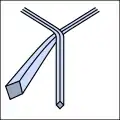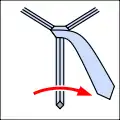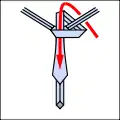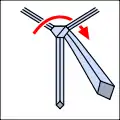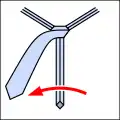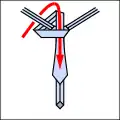Pratt knot
The Pratt knot is a method of tying a necktie. It is also known as the Shelby knot[1][2][3] and the Pratt-Shelby. The knot was created by Jerry Pratt, an employee of the US Chamber of Commerce in the late 1950s.[4] It was popularized as the Shelby knot after then 92-year-old Pratt taught it in 1986 to television reporter Don Shelby who he felt had been tying his tie poorly on the air.[5] Shelby then refined the Pratt knot with local clothier Kingford Bavender and wore it on the air with a spread collar where it stood out and attracted attention for its symmetry and trim precision.[6]
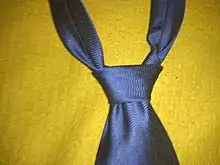
The knot was considered revelatory although strictly speaking it is a variation on the Nicky knot, notable for being tied inside out. As of its popularization in a 1989 New York Times article as well as subsequent UK profile the knot was unknown within the fashion world and not recorded in the tie industry's standard reference guide of the time; Getting Knotted – 188 Knots for Necks, by Davide Mosconi and Riccardo Villarosa in Milan, Italy.[6][7]
The Pratt knot is unusual in that its starting position is 'reverse side out', like the Nicky knot, a self-releasing variant of the Pratt. It uses less length than the half-Windsor or Windsor knots, and so is well suited to shorter ties or taller men. Unlike the four-in-hand knot, the Pratt method produces a symmetrical knot. It is of medium thickness.
Using notation from and according to The 85 Ways to Tie a Tie, the knot is tied
- Lo Ci Lo Ri Co T (knot 5)
The Nicky is tied
- Lo Ci Ro Li Co T (knot 4)
See also
References
- "Don Shelby inspires new 'ShelbyKnot' tie collection – Twin Cities".
- ""Don Shelby" tie knot – Google Search".
- "Don Shelby Partners with St. Paul Clothier for Necktie Line".
- "As Neckwear Goes, This Knot's News". NYTimes. Retrieved 20 August 2018.
- "Taking a Tip from a Dapper Fan, Anchorman Don Shelby Makes News with the Knot in His Necktie : People.com".
- "As Neckwear Goes, This Knot's News". The New York Times. 30 August 1989.
- Getting Knotted: 188 Knots for Necks : the History, Techniques and Photographs. Ratti. 1 January 1985.
